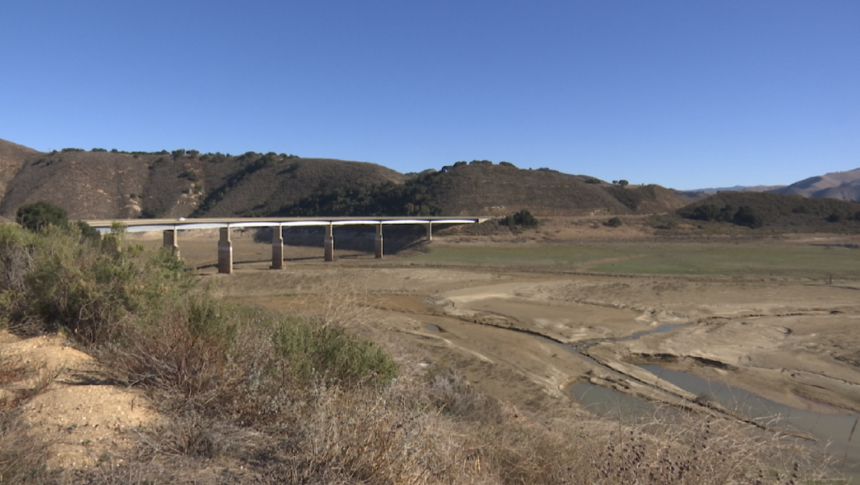Twitchell Reservoir now fully drained, water no longer flowing in Santa Maria River

SANTA MARIA, Calif. – After months of water flowing in the Santa Maria River, the riverbed has once again returned to its more typical dry appearance.
Over the past weekend, water stopped flowing from nearby Twitchell Reservoir east of Santa Maria, which feeds into the riverbed.
"The Twitchell Reservoir terminated the recharge effort that has been ongoing for the last seven months," said Randy Sharer, Twitchell Management Authority Chair. "I don't have an accurate account on what was recharged within the basin, but suffice it to say the reservoir recharge the Santa Maria Basin with well over a year's worth of annual extraction."
According to the Santa Barbara County Flood Control District, the current capacity of Twitchell Reservoir is listed at just 0.7%, a significant difference from earlier this year when the water reached levels not seen in many years.
In late March, the reservoir, which is located about 10 miles east of Santa Maria along the Northern Santa Barbara and South San Luis Obispo county line, measured at 57% capacity.
"The storms of winter 2022, spring 2023 created optimal infiltration opportunity for the releases coming out of the reservoir," said Sharer. "The high flows truly scoured out the riverbed and optimized the infiltration that allowed the water to percolate into the groundwater better than it has in the last 25 years, so we had ideal conditions with an ample amount of water, able to do again what its purpose was intended for, which is to capture stormwater and then release it and get it into the ground to enhance the Santa Maria Basin's aquifer."
Even though water is no longer visibly flowing in the riverbed, Sharer explained there is still water moving within the riverbed.
"The Santa Maria River technically never ceases to flow even in the driest of years," said Sharer. "It's a subsurface channel and there's just not adequate supplies to bring it up to the surface and be above, so you're going to see what historically has been the case for the last 65 years since the construction of the reservoir, a dry riverbed, and hopefully it doesn't stay that way for much longer with winter rains anticipated."
Sharer added with so much rain this past winter, helping refill Twitchell Reservoir, along with the subsequent release into the Santa Maria River, may happen more easily this coming winter.
"It would not require the same amount of precipitation to make a substantial accumulation in the reservoir," said Sharer. "All the coastal reservoirs this year, because you have a lot of surface water that is flowing in the backcountry. Everything is quite well hydrated compared to a year ago or even on normal years, so, we're going to be adding water with the beginning of the rainy season, water on top of already wet soils in the backcountry. With sufficient early precipitation, we should see surface water flows on all of these coastal rivers."
While Twitchell Reservoir is now empty, other nearby lakes and reservoirs that serve as suppliers of drinking water, are at much higher levels since their release is at a much lesser rate.
Outside Arroyo Grande, Lopez Lake is nearly 95% capacity even after experiencing relatively dry summer and fall seasons.
"Right now, the lake levels at 94.7%," said Craig Duprey. Lopez Lake Supervising Park Ranger.
"This exact time last year, we were around 21%. "When we had all the storms over the winter, that excess rain really recharged the streams and it kept on flowing a lot longer into the season, and so that's one of the reasons why we're seeing such a high level right now, and it's not going to take much moderate rainfall for the lake to spill again."
In March, Lopez Lake spilled over its dam for the first time in 25 years, a sight that attracted visitors to the lakes for weeks.
Now several months later, Duprey said the lake's high level is still bringing people to the popular county park on a daily basis.
"We get people out here all the time commenting on how much the lake is filled over the last year and especially a lot of locals there, even though they lived out here and see the lake go up and down over the years, they're pretty excited and they come out and they liked to just check out the lake," said Duprey. "Having a high lake level, it really is great for recreation and the community. We're seeing a lot more boaters coming out and enjoying the lake. Even hikers and and folks camping. There's more for them to do with a full lake. And not only that, having a high lake is really important for recharging the aquifers, so not just recreation, but also for the domestic water supply, having a full lake is is really been beneficial to the Five Cities."
In addition to Lopez Lake, other notable Central Coast lakes and reservoirs are enjoying much higher than usual capacity numbers.
Lake Nacimiento in Northern San Luis Obispo County is currently listed at 55% capacity, while at nearby Lake San Antonio just across the Monterey County line, current capacity is a little big higher at 64%.
In Santa Barbara County, Cachuma Lake at 89% capacity, while further south in Ventura County, Lake Casitas is at 70%.
